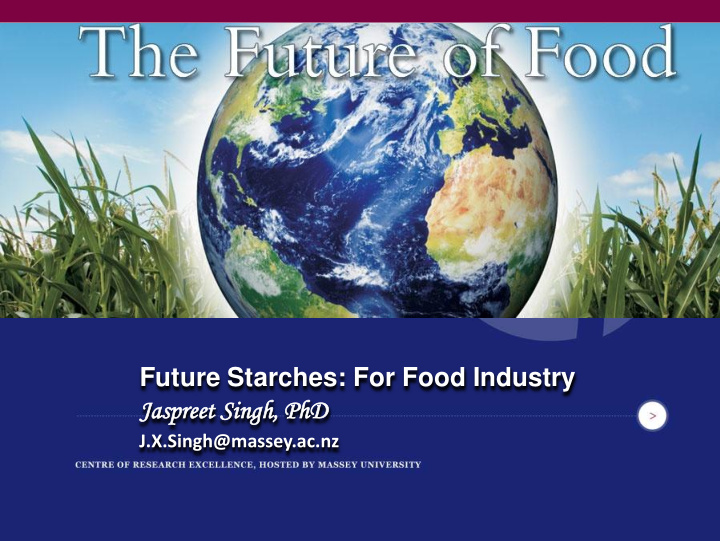



Future Starches: For Food Industry Jaspreet spreet Singh gh, , PhD hD J.X.Singh@massey.ac.nz
Centre of Research Excellence (CoRE) for foods and nutrition, funded by New Zealand Government and supported by local/international food industry Internationally renowned and well-connected A collaborative partnership between academics/ researchers from: 2 2
Auckland Riddet Institute: A National (University of Auckland, Plant & Food) Centre of Research Excellence Hamilton (CoRE) based in Palmerston (AgResearch) North Palmerston North Bringing together (Massey University, Plant & Food, AgResearch, Fonterra) New Zealand’s Wellington best talent in food and (Victoria University, nutritional sciences MacDiarmid Institute) Christchurch (Plant and Food, University of Canterbury, AgResearch) Dunedin (University of Otago)
A Centre of Research Excellence with Global Connections UK S Korea Netherlands Canada Ireland France Germany USA Japan Australia New Zealand
Major International/National Clients BASF (Germany) Dilmah (Sri Lanka) DSM (Netherlands) DSM Asia Pacific (Singapore) Fonterra (NZ) PepsiCo (US & Asia) Yashili (China) Zespri International (NZ)
The Riddet Institute Japan Connection Research Collaborations with: Kumamoto University University of Shizuoka Tokyo University of Marine Science And Technology A two day Japan-New Zealand Functional Food Workshop at the Riddet Institute in July, 2009
Riddet Institute Research Platforms Food material and structure Innovative Food Solutions Food Modelling Gastro- Digestion and Materials and Intestinal bioavailability and Engineering Biology Structures Chemistry, Physics, Mathematics, Engineering, Biology, Materials Science, Nanotechnology, Digestive Physiology Food product design for targeted benefit Nutrition, Microbial Ecology 7
Corn OUR WORLD AND FOOD
Future Foods-Different For Different People Need Low Calorie Foods Need High Calorie Foods Corn
Designing Future Foods – Lessons from Nature “All foods pass through a common Understanding of the human unit operation, the GI tract, yet it digestive machine is the least studied and least Understanding of how food structure understood of all of the food changes as it traverse through the processes. ” entire GIT Norton, I., Fryer, P. and Moore, S. (2006) AIChE Understanding the metabolic and Journal 52: 1632-1640. physiological consequences Can we make the desirable structures
Starch – An Important Food Ingredient In Our Diet Corn
Major Starch Sources Corn
Starch - A Carbohydrate Polymer A major storage polysaccharide present in plants in the form of granules mainly comprised of amylose and amylopectin chains
Starch - A Carbohydrate Polymer Amylose - a linear polymer composed of CH 2 OH glucose units linked through -D- (1 4) glycosidic linkages 1 , 1-6 bond 6 CH 2 5 1 1 4 3 2 , 1-4 bond Amylopectin - a branched polymer with linear -D-(1 4) linked glucose units and additional -D-(1 6) glycosidic linked branch points Minor constituents (Phosphorus, lipids and proteins)
Starch Characteristics- Gelatinization of Starch Sol to Gel a = Total protein calculated by nitrogen X 6.25 b = Total carbohydrate calculated by difference
Starch Characteristics- Viscosity (Rheological Characteristics)
Starch Characteristics- Retrogradation of Starch a = Total protein calculated by nitrogen X 6.25 b = Total carbohydrate calculated by difference
Digestibility of Starch in Human System Raw Starch Gelatinized Starch Contain some resistant starch Non digestible in human Digestible in human system system Retrograded Starch Very high in resistant starch Less digestible in human system
Starch Digestion Depends On Starch Structure Nature of Food Matrix Starch Processing Procedure and Storage Conditions
In vitro Starch Digestion pH electrode Step 1 : Jacketed reactor Simulated gastric juice - pepsin (37°C) Water pH =1.2; Duration :30 min outlet Step 2 : Magnetic Water bar Simulated intestinal juice inlet Pancreatin, amyloglucosidase pH = 6.8; Duration :2h Peristaltic pump to adjust automatically the pH 20
Native Starch Structure vs Digestibility
Development of Novel Starch Structures Slowly (or may be medium) digestible starch structures Good functional characteristics for use in different food products No safety issues
Spherulites : A Novel Starch Structure
High Temperature (140°C) Starch granule + Water Fatty acid 25°C 50°C 140°C High Temperature Retrogradation Fatty Amylose acids
Production of Spherulites at Pilot Scale High Amylose Starch Fatty Acids
Relative Crystallinity Birefringence 26
Development of Food Matrix Polysaccharide Starch Gums
Glucose Release During In vitro Digestion 100 90 80 70 % hydrolysis 60 50 Less Glucose Release/Less Starch Hydrolysis 40 30 20 10 0 0 20 40 60 80 100 120 140 Stomach Small Intestine Time (min) 4% Waxy Starch - 0% Guar Gum 4% Waxy Starch - 1% Guar Gum
In vitro Digestion Normal Maize Starch Simulated intestinal juice On line recording of In vitro Digestion Real time : 16 min
In vitro Digestion Normal Maize Starch + 1% Gum On line recording of In vitro Digestion Real time : 10 min
Acknowledgements Future Foods Funding – Foundation for Research Science and Technology (FoRST), New Zealand Researchers, students, technical staff of carbohydrates group at Riddet Institute
Recommend
More recommend